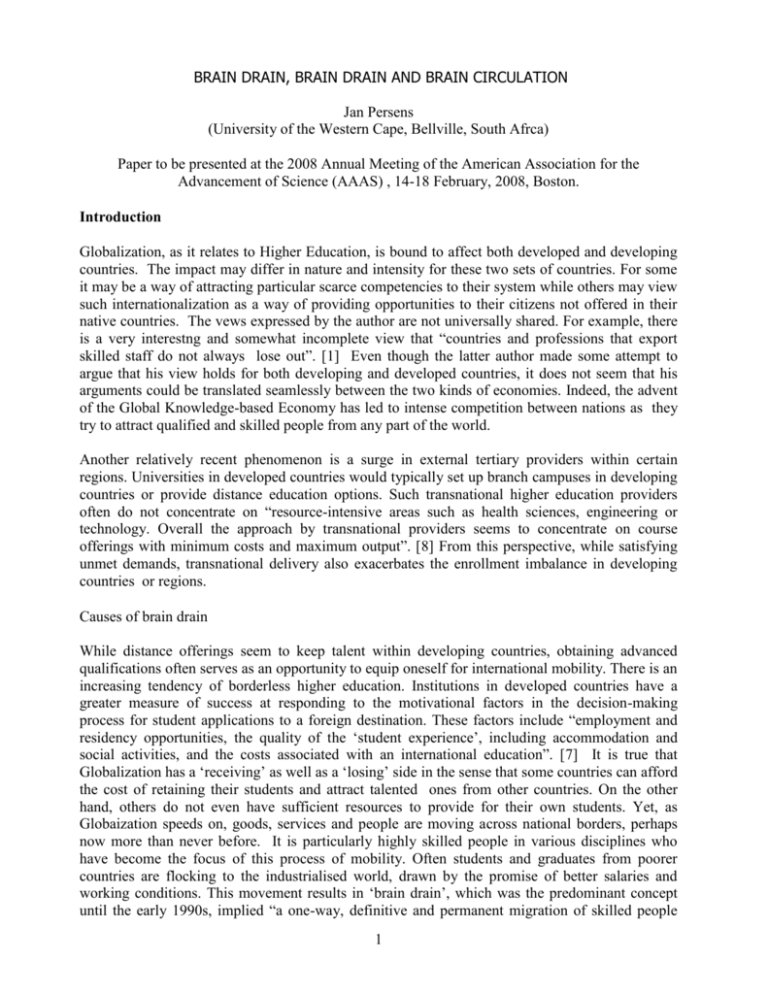CAUSES AND REMEDIES OF BRAIN DRAIN
advertisement

BRAIN DRAIN, BRAIN DRAIN AND BRAIN CIRCULATION Jan Persens (University of the Western Cape, Bellville, South Afrca) Paper to be presented at the 2008 Annual Meeting of the American Association for the Advancement of Science (AAAS) , 14-18 February, 2008, Boston. Introduction Globalization, as it relates to Higher Education, is bound to affect both developed and developing countries. The impact may differ in nature and intensity for these two sets of countries. For some it may be a way of attracting particular scarce competencies to their system while others may view such internationalization as a way of providing opportunities to their citizens not offered in their native countries. The vews expressed by the author are not universally shared. For example, there is a very interestng and somewhat incomplete view that “countries and professions that export skilled staff do not always lose out”. [1] Even though the latter author made some attempt to argue that his view holds for both developing and developed countries, it does not seem that his arguments could be translated seamlessly between the two kinds of economies. Indeed, the advent of the Global Knowledge-based Economy has led to intense competition between nations as they try to attract qualified and skilled people from any part of the world. Another relatively recent phenomenon is a surge in external tertiary providers within certain regions. Universities in developed countries would typically set up branch campuses in developing countries or provide distance education options. Such transnational higher education providers often do not concentrate on “resource-intensive areas such as health sciences, engineering or technology. Overall the approach by transnational providers seems to concentrate on course offerings with minimum costs and maximum output”. [8] From this perspective, while satisfying unmet demands, transnational delivery also exacerbates the enrollment imbalance in developing countries or regions. Causes of brain drain While distance offerings seem to keep talent within developing countries, obtaining advanced qualifications often serves as an opportunity to equip oneself for international mobility. There is an increasing tendency of borderless higher education. Institutions in developed countries have a greater measure of success at responding to the motivational factors in the decision-making process for student applications to a foreign destination. These factors include “employment and residency opportunities, the quality of the ‘student experience’, including accommodation and social activities, and the costs associated with an international education”. [7] It is true that Globalization has a ‘receiving’ as well as a ‘losing’ side in the sense that some countries can afford the cost of retaining their students and attract talented ones from other countries. On the other hand, others do not even have sufficient resources to provide for their own students. Yet, as Globaization speeds on, goods, services and people are moving across national borders, perhaps now more than never before. It is particularly highly skilled people in various disciplines who have become the focus of this process of mobility. Often students and graduates from poorer countries are flocking to the industrialised world, drawn by the promise of better salaries and working conditions. This movement results in ‘brain drain’, which was the predominant concept until the early 1990s, implied “a one-way, definitive and permanent migration of skilled people 1 from developing to industrial(ised) countries”. [Meyer 2] Interestingly, while the negative connotation implied that “it involved a loss of vital resources”, some in the developing countries “also argued that ... it avoided a ‘brain waste’” because developing countries sometimes could not provide developmental and capacity building opportunities for their skilled citizens. Not everyone is happy with this arrangement of mobility. Many, including governments of some developing countries, insist that this phenomenon must be curbed. Others view the situation with greater optimism, pointing out potentially significant benefits for countries of origin. ‘Brain gain or re-gain’ would require creating more favourable conditions for citizens who might have left their contries of origin because they could not find satisfactory conditions in their countries in the first place. For most developing countries such a strategy will be unaffordable. Brain Circulation: The in-between situation My gut feeling is that, in the final analysis, it may not be a matter of ‘brain drain’ versus ‘brain gain’ but rather ‘brain circulation’as a potential ´win-win´ situation. It is in this sense that some leaders in developing countries “also argued that (‘brain drain”) avoided a ‘brain waste’” [2] because developing countries sometimes could not provide developmental and capacity building opportunities for their skilled citizens. I think that it is crucal that efforts at mitigating against brain drain must be explicit and achievable otherwise the impact may be insignificant. In this regard the meeting of government ministers from 58 European and African countries in Rabat, Morocco in July 2006, was a step in the right direction. “They approved an action plan which ... calls for Euro-African partnerships and networks ... with a focus on training courses for young African professionals.” [6] The idea of establishing regional centres of excelence in the South and the support for existing centres was also included in this plan. This plan represents a ‘softer’ and more realistic or achievable option compared to ‘brain gain’. Meyer [1] argues that the paradigm shift from ‘bran drain’ to ‘brain circulation’ is probably the best scenario one could hope for. Thus, “the mobility of highly skilled manpower/human resource should be seen as a normal process that should not be stopped, and that the real challenge is therefore to manage it as well as possible”. [2] Already “the conditions that govern mobility have changed dramatically especially due to the emergence of new forms of communication, transportation, geopolitics, intercultural relationships and commerce”. As a result, mobility has lost some of the traditional features that led it to being characterized as a ‘brain drain’. Possible Remedies or slowdown options In the ‘brain circulation’ paradigm the counting process of mobility of talent is much more nonlinear and asymmetric due to the complex nature of the mobility phenomenon. In fact, such asymmetry in brain circulation may be favoured by countries of origin who may, without explicitly spelling it out, benefit from a policy of “storing brain power overseas” [2] for subsequent use as it was experienced by Korea and Taiwan and more recently by China and India. These countries have experienced a massive return of expatriates through which the ‘brain drain’ has somewhat been reversed. In several Latin American and African countries this is not yet the case. It is clear that “Africa needs partnerships that both harness the innovation potential of university research and meet the needs for development” [3]. However, there is always the perceived danger that academic integrity can be sacrificed when a university-industry research relationship is 2 established. It is, therefore crucial that detrimental partnerships should be avoided, especially those which are only aimed at supplementing the salaries of researchers without encouraging publications. It is also important that government policies in developing countries must be aimed at retarding ‘brain drain’ from their countries. In this regard the public undertaking of the relatively new science minister of Zambia, Brian Chituwo, must be applauded. He said in late 2006 that his “focus for the next five years will be to rehabilitate research infrastructure and tackle the scientific brain drain”. [4] Creating Research Possibilities for Young Faculty Members and post-graduate students in developing countries can be achieved in a number of ways. Serious and meaningful cooperation could lead to sharing of knowledge and enhancing of research skills. Often developing countries cannot afford to develop a reasonable number of institutions with research capacities. Young researchers may then find themselves isolated. Even better, the establishment of research networks as a result of the need to collaborate, will extend opportunities for skills development on a broader scale. Networking with a view of becoming part of a critical mass of researchers, without necessarily being in close proximity, might be a viable option. Computer simulations and demonstrations as well as high-speed computations can all become tools to enhance the development of local skills. Given the role of computations in a number of areas in mathematics, computational strengths are often required. Young faculty members must try to acquire such computational skills and abilities of remote accessing of computational facilities. It goes without saying that research can become a major challenge when done in isolation. Being part of a team is crucial for research development at the early stage of the endeavour. Often it is about sharing of ideas or struggling together in understanding or even solving a problem. It is therefore strongly suggested that young faculty members in developing countries should try their utmost and should be assisted to become part of a research team. Enrolling in post-doctoral studies is, however, a crucial step in developing or enhancing research skills and capacity, especially if it can be done at an institution in a developed country. In doing so, a young faculty member will grow in confidence and be exposed to ways of overcoming some of these infrastructural challenges. Every effort should therefore be made to enroll such young researchers in post-doctoral studies. Being involved in national and/or regional centres of excellence, hosting relatively expensive research equipment, may provide access to appropriate research opportunities. There is, however, also an argument that “centres of excellence (are) not good for African science ... becuase (they) will concentrate development in just a few countries, condemning the rest of the continent to the status quo.” [4] Our argument is that these centres should exactly NOT be national centres but regional centres. It is also expected their management will be multi-national. Applied research often requires research of a interdisciplinary nature. Without necessarily giving in to externally defined research agendas by industry or donors, an interdisciplinary 3 approach often provides more research material and possibilities. Such research may often be of relevance to developing needs. References 1. “In praise of the ‘brain drain’”; published on line Nature@nature.com; 14 March 20072. Meyer, Jean-Baptiste; “Policy implications of the brain drain’s changing face”; Science and Developent Network, May 2003 3. Kruss, Glenda; “University-Industry link: Lessons from South Africa”, Science and Development Network, 29 November 2006 4. Ngandwe,Talent; “Zambia’s new science minister will atckle brain drain”, Science and Development Network, 3 November 2006 5. Lewanika, Mwananyyanda Mbikusita; Science and Developemnt Network, 13 December 2006 6. Sawahel, Wagdy; “Plans launched to mitigate African brian drain”, Science and Development Network, 19 July 2006 7. “The Observatory on borderless higher education”, published on line http://www.obhe.ac.uk/products/reports/ , Obsevatory Reports, 10/08/2007 8. Aupetit, Sylvie Didou and Jokivirta, Lisa; “Higher Education Crossing Borders in Latin America and the Caribbean”, International Higher Education, Number 49, Fall 2007 4




